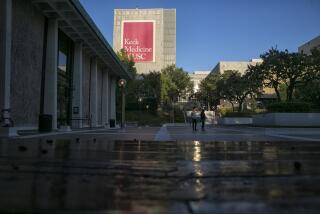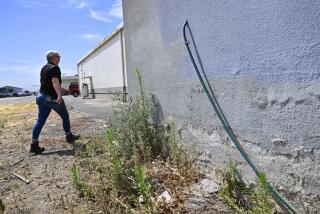California’s stem cell scandal gets worse
Anyone who cares about the advance of medical science and about the promise of biotechnology should be dismayed by how badly the California stem cell agency has handled its latest conflict-of-interest scandal.
We reported on the scandal last week, but developments since then are making it look worse.
The agency, known formally as the California Institute for Regenerative Medicine, or CIRM, continues to demonstrate the drawbacks of its insidery way of doing business. This is the legacy of Proposition 71, the 2004 ballot initiative that created the agency and made it immune from accountability to the state legislature--or practically speaking, any elected officials. CIRM’s endowment comes from $3 billion in state bond funds backed by the taxpayers, who are also on the hook for $3 billion in interest, so the issues aren’t trivial.
To recap the latest fiasco, CIRM’s former president, Alan Trounson, accepted a position on the board of directors of one of its highest-profile grantees, Stem Cells Inc., on July 7, a mere seven days after leaving CIRM. The deal blindsided CIRM, which had no idea it was in the works until Stem Cells publicly announced Trounson’s appointment. Trounson had been CIRM president since 2007.
CIRM promptly said it would investigate its relationship with Stem Cells to determine if Trounson had shown the company any favoritism.
That’s where things have gone downhill.
To begin with, CIRM placed the investigation in the hands of its law firm, San Leandro-based Remcho, Johanson, and Purcell. The Remcho firm is the antithesis of an objective, independent party; its lead partner on the CIRM account, James Harrison, has been a CIRM insider from the start. He helped draft Proposition 71. He’s been counsel to the agency or its governing board since 2005.
As it turned out, Harrison couldn’t conduct the investigation himself, because he was involved in some of the transactions with Stem Cells Inc. under review. Instead of hiring an independent law firm to do the job, CIRM allowed the review to be turned over to Harrison’s own partner, Margaret R. Prinzing.
Trounson hasn’t been available for comment; Prinzing reported that he was back in his Australia home, and she herself communicated with him by email. Stem Cells declined Friday to our request for comment. We’ve reached out for comment to the law firm, and will update if we hear back.
In her report, dated July 22, Prinzing found “no evidence that Dr. Trounson made, participated in making, or attempted to influence” CIRM decisions relating to the company since May 1.
That was the date when Trounson began discussions about a new job with Stem Cells--in other words, while he was still employed by CIRM. On June 9, Trounson was offered the seat on the company’s board. Because not a word was said to CIRM about any of this, Prinzing reports, the agency took no steps to “wall off Dr. Trounson from any involvement in decisions relating to SCI.”
But Prinzing’s inquiry was much too narrow. It was limited only to transactions between CIRM and Stem Cells subsequent to the start of Trounson’s job search. But CIRM’s relationship with the company dates much further back than May 1--and the evidence suggests that Trounson was involved in earlier decisions that could have had an impact on Stem Cells Inc.
Consider the CIRM board’s meeting on Sept. 5, 2012. On that date it approved a nearly $20 million grant to the company. (Technically, the approval was for a loan, but it doesn’t have to be repaid unless it results in a commercially viable product, which may not ever happen.)
The Stem Cells application, covering a possible therapy for Alzheimer’s, had been rejected twice by CIRM’s scientific reviewers. But the company had powerful friends, including Robert Klein II, the real estate developer who spearheaded the Proposition 71 campaign and became CIRM’s first chairman, and Irving Weissman, a prominent Stanford stem cell scientist, a friend of Klein’s, a major recipient of CIRM grants, a co-founder of the company, and member of its board.
Trounson didn’t speak on the Stem Cells application during that September meeting. But he did weigh in on another Alzheimer’s proposal from researchers at USC and UC Davis, which had received a higher score from the reviewing panel. That proposal, like the Stem Cells application, had already been rejected once by the CIRM board, and had come back on appeal.
At the September meeting, Trounson told the CIRM board that the scientific reviewers had misgivings about whether the USC/UC Davis proposal was sufficiently stem-cell oriented to fit within CIRM’s portfolio. He didn’t speak out against the application, but merely passed along the grant reviewers’ doubts. “It remains questionable, and I think you have to decide yourselves on it,” he told the board.
It isn’t clear whether approval of that proposal necessarily would have killed the Stem Cells application--theoretically, both could have been approved. But the board then was looking for one Alzheimer’s project to fill out its disease-therapy portfolio, and Stem Cells got the nod. The board rejected the USC/UC Davis application, 10-4.
In any case, Trounson plainly was participating in discussions that carried possible implications for his future employer, as far back as 2012. One of the competing researchers, Lon S. Schneider of USC, has said in a note to David Jensen of the California Stem Cell Report that “Mr. Trounson and the CIRM staff were clearly antagonistic to us and strongly supportive of StemCells.”
One other aspect of the Stem Cells deal revealed in Prinzing’s report is that the company may be standing on shaky financial ground.
In late June, the company informed CIRM that it could not meet the financial standards required before a semi-annual $3.8-million disbursement from its CIRM grant could be paid. The firm asked for a partial payment anyway, and CIRM agreed to front $977,000. The check had been cut and was in an envelope ready for delivery when news arrived of Trounson’s appointment, at which point it was canceled.
A CIRM spokesman says the money still hasn’t been paid, pending completion of the agency’s investigation. Also in abeyance, for the moment, is a Stem Cells request that its CIRM loan be subordinated to a future corporate debt offering. The decisions on the partial check and the subordination were among those that were reviewed by Prinzing to determine if Trounson played a role.
Here’s what we know so far: A well-connected company with questionable finances and a research proposal of uncertain scientific validity has received favorable treatment from CIRM. An investigation of the relationship between the firm and CIRM’s management was placed in the hands of a law firm inextricably entwined with management, and given an inappropriately narrow scope. The unanswered question burning a hole through CIRM’s credibility is whether Stem Cells Inc. got its money because its research was promising, or because it knew the right people.
For most of its existence, CIRM has been deeply hostile to outside scrutiny. The harvest is now coming in.
The immunity from oversight that Proposition 71 gave CIRM was based on the assertion by Klein and his fellow sponsors that stem cell science was too important to risk interference from politicians.
That’s ironic in retrospect, because no amount of legislative oversight could have done more damage to CIRM’s credibility than it has done to itself by its arrogance and administrative ineptitude.
That credibility is draining away, day by day, and California science is poorer for it.
>Keep up to date with The Economy Hub by following @hiltzikm







